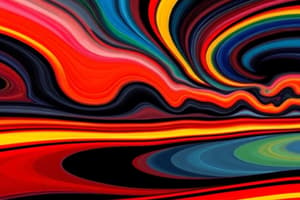Podcast
Questions and Answers
What is the main reason for the Doppler effect?
What is the main reason for the Doppler effect?
- The simultaneous transportation of waves
- The finite speed of sound waves (correct)
- The finite speed of electromagnetic waves (correct)
- The infinite speed of light waves
What happens to the wavelengths in front of the wave source's motion?
What happens to the wavelengths in front of the wave source's motion?
- They disappear
- They get spaced out
- They remain constant
- They get bunched up (correct)
What is the Doppler effect observed as in sound waves?
What is the Doppler effect observed as in sound waves?
- A change in frequency
- A change in amplitude
- A change in pitch (correct)
- A change in color
What happens when the distance between a wave source and an observer decreases?
What happens when the distance between a wave source and an observer decreases?
What is the name of the phenomenon observed when the source of sound waves is traveling faster than the speed of sound?
What is the name of the phenomenon observed when the source of sound waves is traveling faster than the speed of sound?
What is the term used to describe the shift in color towards the color red?
What is the term used to describe the shift in color towards the color red?
Why is the Doppler effect relevant in the study of distant galaxies?
Why is the Doppler effect relevant in the study of distant galaxies?
What is observed when a wave source is moving away from an observer?
What is observed when a wave source is moving away from an observer?
What happens to the wavelengths behind the wave source's motion?
What happens to the wavelengths behind the wave source's motion?
Who first described the Doppler effect?
Who first described the Doppler effect?
What is the Doppler effect?
What is the Doppler effect?
What is the actual frequency of a wave?
What is the actual frequency of a wave?
What happens to the apparent frequency of a wave when the source is moving towards the observer?
What happens to the apparent frequency of a wave when the source is moving towards the observer?
What is represented by the symbol 'c' in the Doppler effect formula?
What is represented by the symbol 'c' in the Doppler effect formula?
When is the value of 'v' added in the Doppler effect formula?
When is the value of 'v' added in the Doppler effect formula?
What is the Doppler effect caused by?
What is the Doppler effect caused by?
What is the apparent frequency of a wave when the source is moving away from the observer?
What is the apparent frequency of a wave when the source is moving away from the observer?
What represents the speed at which the wave source is traveling relative to the medium in the Doppler effect formula?
What represents the speed at which the wave source is traveling relative to the medium in the Doppler effect formula?
What is frequency in the context of waves?
What is frequency in the context of waves?
What is a necessary condition for the Doppler effect to occur?
What is a necessary condition for the Doppler effect to occur?
Flashcards are hidden until you start studying
Study Notes
Definition of the Doppler Effect
- The Doppler effect is the perceived change in frequency of a wave due to the motion of the wave source relative to an observer.
- Actual frequency refers to the source's oscillation rate, while apparent frequency varies based on the source's motion.
- If the wave source approaches the observer, the apparent frequency increases; if it moves away, the apparent frequency decreases.
Wave Propagation and Frequency Change
- Frequency is defined as the number of waves passing a point in one second.
- The formula for frequency change considers:
- c: speed of wave propagation in a medium.
- v_observer: speed of the observer relative to the medium.
- v_source: speed of the wave source relative to the medium.
- Moving sources compress wavelengths ahead and elongate those behind due to finite wave propagation speed.
Phenomena of the Doppler Effect
- First described by Austrian physicist Christian Doppler in 1842.
- With sound waves:
- Increased pitch occurs as the distance to the source decreases.
- Decreased pitch occurs as the distance increases.
- A sonic boom occurs when a sound source exceeds the speed of sound.
Light Waves and the Doppler Effect
- For electromagnetic waves, colors shift rather than pitches.
- Red shift occurs when a wave source moves away, shifting perceived light toward red.
- Blue shift occurs when a wave source approaches, shifting light toward blue/violet.
- Light's rapid speed makes everyday perception of color shifts negligible but significant in astronomy.
Astronomical Significance
- Edwin Hubble noted that most galaxies exhibit redshift, indicating they are moving away from Earth, supporting the Big Bang theory and suggesting an expanding universe.
- Advanced technology like the Hubble Space Telescope is used to detect these shifts.
Real-World Examples
- An ambulance's siren sounds higher as it approaches and lower as it moves away from an observer.
- A duck creates waves that bunch in front and spread behind as it paddles across water.
- Doppler radar utilizes microwaves to measure velocity, calculating changes in frequency based on returned waves.
- This technology is applied in police radar guns and weather radar for detecting precipitation density.
Studying That Suits You
Use AI to generate personalized quizzes and flashcards to suit your learning preferences.




